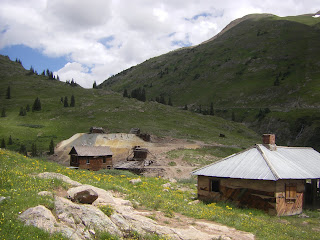










After spending the night in Durango, we headed out to Mesa Verde.
I had been there in 1999 with Steve and Rita, but I guess I didn't remember it very well. I had also been there around 1975 on a family vacation.
You drive in and immediately start climbing, and before you know it, you're 1500 feet above the surrounding plane. It's sort of like being on a huge flat mountain.
We wanted to tour the cliff houses, but the wait was over 4 hours to get on one of the guided tours.
The temperature was oppressive. We had just spent almost a week in the mountains with brisk nights and pleasant days, and this brutal sun and arid desert-like atmosphere seemed to suck the moisture right out of you. There were areas that had been burned back in 2000 and they were still pretty barren and desolate looking.
When you got up to the edge of the mesa, it really dropped off quickly. You felt like you were staring off the edge of a wall. It really made you wonder what the people were thinking of, to put homes in the side of the canyon wall like that.
It's hard to believe that so many of these amazing dwellings were built almost 1000 years ago, lived in for less than 100 years, and then abandoned.



































